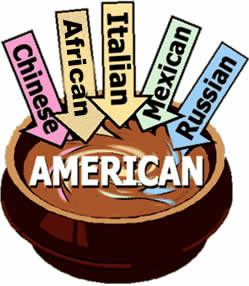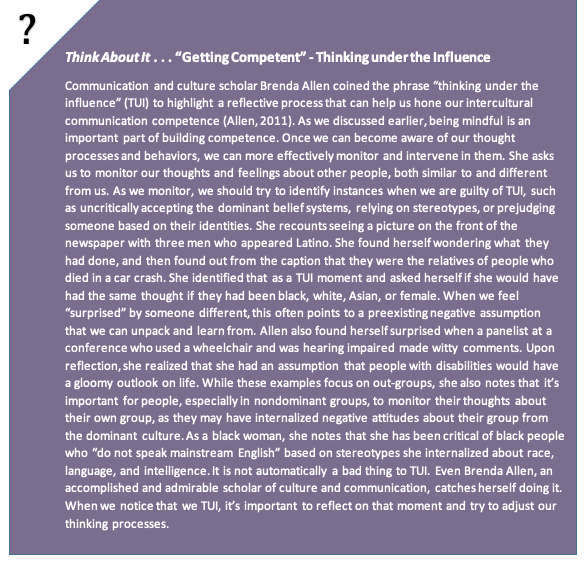Competent communication is interaction that is perceived as effective in fulfilling certain rewarding objectives in a way that is also appropriate to the context in which the interaction occurs.
BASIC dimensions of intercultural competence.
· Orientation to Knowledge - The terms people use to explain themselves and the world around them.
· Empathy - The capacity to behave as though you understand the world as others do.
· Interaction Management - Skill in regulating conversations.
· Task Role Behavior - Behaviors that involve the initiation of ideas related to group problem-solving activities.
· Relational Role Behavior - Behaviors associated with interpersonal harmony and mediation.
· Tolerance for Ambiguity Interaction Posture - The ability to react to new and ambiguous situations with little visible discomfort.
· Display of Respect - The ability to show respect and positive regard for another person.
· Interaction Posture - The ability to respond to others in descriptive.
Intercultural communication competence (ICC) is the ability to communicate effectively and appropriately in various cultural contexts. There are numerous components of ICC. Some key components include motivation, self- and other knowledge, and tolerance for uncertainty.
Initially, a person’s motivation for communicating with people from other cultures must be considered. Motivation refers to the root of a person’s desire to foster intercultural relationships and can be intrinsic or extrinsic (Martin & Nakayama, 2010). Put simply, if a person isn’t motivated to communicate with people from different cultures, then the components of ICC discussed next don’t really matter. If a person has a healthy curiosity that drives him or her toward intercultural encounters in order to learn more about self and others, then there is a foundation from which to build additional competence-relevant attitudes and skills. This intrinsic motivation makes intercultural communication a voluntary, rewarding, and lifelong learning process. Motivation can also be extrinsic, meaning that the desire for intercultural communication is driven by an outside reward like money, power, or recognition. While both types of motivation can contribute to ICC, context may further enhance or impede a person’s motivation to communicate across cultures.
Members of dominant groups are often less motivated, intrinsically and extrinsically, toward intercultural communication than members of nondominant groups, because they don’t see the incentives for doing so. Having more power in communication encounters can create an unbalanced situation where the individual from the nondominant group is expected to exhibit competence, or the ability to adapt to the communication behaviors and attitudes of the other. Even in situations where extrinsic rewards like securing an overseas business investment are at stake, it is likely that the foreign investor is much more accustomed to adapting to United States business customs and communication than vice versa. This expectation that others will adapt to our communication can be unconscious, but later ICC skills we will learn will help bring it to awareness.
The unbalanced situation just described is a daily reality for many individuals with nondominant identities. Their motivation toward intercultural communication may be driven by survival in terms of functioning effectively in dominant contexts. This is a form of code-switching in which individuals from nondominant groups adapt their communication to fit in with the dominant group. In such instances, African Americans may “talk white” by conforming to what is called “standard English,” women in corporate environments may adapt masculine communication patterns, people who are gay or lesbian may self-censor and avoid discussing their same-gender partners with coworkers, and people with nonvisible disabilities may not disclose them in order to avoid judgment.
While intrinsic motivation captures an idealistic view of intercultural communication as rewarding in its own right, many contexts create extrinsic motivation. In either case, there is a risk that an individual’s motivation can still lead to incompetent communication. For example, it would be exploitative for an extrinsically motivated person to pursue intercultural communication solely for an external reward and then abandon the intercultural relationship once the reward is attained. These situations highlight the relational aspect of ICC, meaning that the motivation of all parties should be considered. Motivation alone cannot create ICC.
Knowledge supplements motivation and is an important part of building ICC. Knowledge includes self- and other-awareness, mindfulness, and cognitive flexibility. Building knowledge of our own cultures, identities, and communication patterns takes more than passive experience (Martin & Nakayama). Developing cultural self-awareness often requires us to get out of our comfort zones. Listening to people who are different from us is a key component of developing self-knowledge. This may be uncomfortable, because we may realize that people think of our identities differently than we thought.. They perceived US Americans to be shallow because they were friendly and exciting while they were in Sweden but didn’t remain friends once they left. The most effective way to develop other-knowledge is by direct and thoughtful encounters with other cultures. However, people may not readily have these opportunities for a variety of reasons. Despite the overall diversity in the United States, many people still only interact with people who are similar to them. Even in a racially diverse educational setting, for example, people often group off with people of their own race. While a heterosexual person may have a gay or lesbian friend or relative, they likely spend most of their time with other heterosexuals. Unless you interact with people with disabilities as part of your job or have a person with a disability in your friend or family group, you likely spend most of your time interacting with able-bodied people. Living in a rural area may limit your ability to interact with a range of cultures, and most people do not travel internationally regularly. Because of this, we may have to make a determined effort to interact with other cultures or rely on educational sources like college classes, books, or documentaries. Learning another language is also a good way to learn about a culture, because you can then read the news or watch movies in the native language, which can offer insights that are lost in translation. It is important to note though that we must evaluate the credibility of the source of our knowledge, whether it is a book, person, or other source. Also, knowledge of another language does not automatically equate to ICC.
Developing self- and other-knowledge is an ongoing process that will continue to adapt and grow as we encounter new experiences. Mindfulness and cognitive complexity will help as we continue to build our ICC (Pusch, 2009). Mindfulness is a state of self- and other-monitoring that informs later reflection on communication interactions. As mindful communicators we should ask questions that focus on the interactive process like “How is our communication going? What are my reactions? What are their reactions?” Being able to adapt our communication in the moment based on our answers to these questions is a skill that comes with a high level of ICC. Reflecting on the communication encounter later to see what can be learned is also a way to build ICC. We should then be able to incorporate what we learned into our communication frameworks, which requires cognitive flexibility. Cognitive flexibilityrefers to the ability to continually supplement and revise existing knowledge to create new categories rather than forcing new knowledge into old categories. Cognitive flexibility helps prevent our knowledge from becoming stale and also prevents the formation of stereotypes and can help us avoid prejudging an encounter or jumping to conclusions. In summary, to be better intercultural communicators, we should know much about others and ourselves and be able to reflect on and adapt our knowledge as we gain new experiences.
Motivation and knowledge can inform us as we gain new experiences, but how we feel in the moment of intercultural encounters is also important. Tolerance for uncertainty refers to an individual’s attitude about and level of comfort in uncertain situations (Martin & Nakayama, 2010). Some people perform better in uncertain situations than others, and intercultural encounters often bring up uncertainty. Whether communicating with someone of a different gender, race, or nationality, we are often wondering what we should or shouldn’t do or say. Situations of uncertainty most often become clearer as they progress, but the anxiety that an individual with a low tolerance for uncertainty feels may lead them to leave the situation or otherwise communicate in a less competent manner. Individuals with a high tolerance for uncertainty may exhibit more patience, waiting on new information to become available or seeking out information, which may then increase the understanding of the situation and lead to a more successful outcome (Pusch, 2009). Individuals who are intrinsically motivated toward intercultural communication may have a higher tolerance for uncertainty, in that their curiosity leads them to engage with others who are different because they find the self- and other-knowledge gained rewarding.





